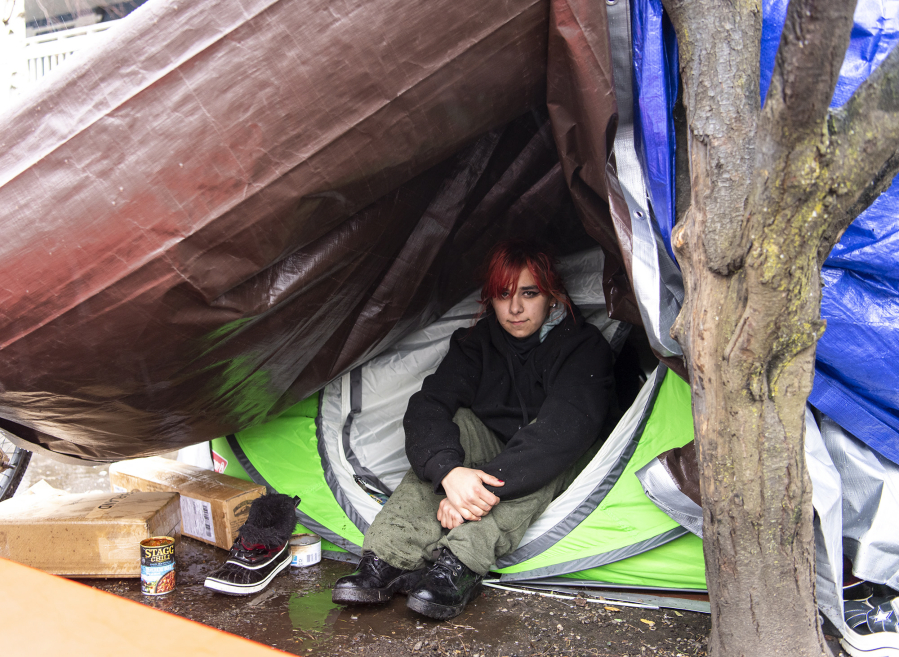Angellina Ricker doesn’t know when she became so terrified of the world. She describes herself as a social butterfly as a little girl, the child who pulled on the pant leg of every adult around her at the grocery store.
Now, she avoids shopping. “I have almost a heart attack every time I go in a grocery store with big crowds of people,” she said. When she thought she might have a concussion in mid-December, she wouldn’t go to the hospital for fear of having a panic attack.
Ricker, 23, spends much of her time in her tent at Vancouver’s downtown homeless encampment outside Share House. She became homeless on her 18th birthday, the day she aged out of the foster care system, she said.
“I thought that I had placement figured out. My foster parents told me I’d still be able to live there after I turned 18 as long as I paid rent,” Ricker said. “Then my social worker called me on my 18th and said, ‘You’ve got till 6 p.m. to find somewhere to go.’”
She spent her first few nights on Vancouver’s streets, sleeping tucked in a playground tunnel. “I remember I cried myself to sleep thinking I was gonna freeze to death,” she recalled.
Kit Kuran, Vancouver Housing Authority director of supportive services, said these types of abrupt transitions out of foster care are not uncommon. “Unless they have a long-term enduring relationship with a foster parent, there’s very little flexibility for them to stay past 18,” Kuran said.
This can result in youth couchsurfing, living outside or moving back in with biological parents, which “usually doesn’t have good outcomes,” according to Kuran. In terms of renting, it’s hard for youth to plan ahead, since apartments typically require applicants to be at least 18.
Ricker bounced between several group homes and foster families in Washington since age 15, when her mom, who struggled with addiction and mental health issues, lost custody of her.
She and her mom previously lived with relatives in Clark County; but when Ricker aged out of state care, her relatives were either not in a position to keep caring for her or didn’t offer their help, she said.
Since aging out, Ricker has couchsurfed and camped on and off by the Marshall Community Center, a place she said felt familiar because she used to swim there as a kid. She moved to the Share House encampment last summer.
“I feel invisible,” she said. “I feel totally shunned.”
‘One is too many’
Ricker is one of thousands of young adults nationwide with nowhere to go after exiting the child welfare system. A 2022 study by Washington’s Department of Social and Health Services found 50 out of 297 (17 percent) of youth who left Washington’s foster care system from July 2019 through June 2020 were homeless within a year.
This statistic hits some demographics harder than others. The 50 homeless youth in the study identified as 30 percent American Indian or Alaska Native, 24 percent Black and 26 percent Latino. Just 38 percent identified as non-Hispanic white, in contrast to Washington’s overall population that is 66 percent non-Hispanic white.
GET HELP
If you are a young person experiencing homelessness and are seeking help, contact the Council for the Homeless Coordinated Outreach Team by leaving a voicemail at 360-450-0802 or emailing outreach@councilforthehomeless.org.
HOW TO HELP
Though Washington’s Department of Children, Youth and Families helps with transition planning for people exiting the child welfare system, with options that include extended foster care for people ages 18-21, some young adults like Ricker still leave with unclear plans, according to Taku Mineshita, the department’s director of integrated systems of care.
The numbers have improved since 2017, when 26 percent of youth leaving Washington’s foster system became homeless within a year. Washington made legislative progress in 2018 with Senate Bill 6560, which was passed to ensure “that no youth is discharged from a public system of care into homelessness.”
But the state recognizes there is still work to be done. “This issue of youth homelessness from the foster care and the system at large is a historical and systemic issue that we have been trying to address over multiple years,” Mineshita said. “One is too many. If they come to our care, and one person is facing homelessness, it’s not acceptable.”
To reach zero, Mineshita thinks the system needs to center on the experiences of foster youth themselves. “I think we have been able to kind of move toward that. Creating the solution with them rather than for them,” he said.
Growing pains
On a local level, the Clark County YWCA Independent Living Skills program helps foster youth ages 15-23 transition out of state care by providing education, financial assistance and resources for housing and employment.
Most program participants don’t have family or other support systems to help with things like co-signing a lease, said Jesse Villaraldo, the program’s interim manager. Youth also might lack IDs, credit history, employment history — basic things needed to apply for housing.
The program assisted more than 100 youth last year across Clark and Skamania counties. Still, it doesn’t have enough funding to meet youth’s housing needs, said Tanika Siscoe, YWCA prevention program manager. “It costs $200 just to apply to an apartment that you may never get, and you won’t get that money back,” Siscoe said.
These functional barriers, combined with emotional challenges of living in the child welfare system, can make transitions difficult.
“Most of the time while they’re in the program, they’re still working on mental health issues and previous trauma that they’ve experienced,” Villaraldo said. “By the time they age out, they’re still dealing with those issues. So that affects them when they’re trying to plan for housing.”
Histories of trauma also make it difficult for former foster youth to trust adults, creating yet another challenge in helping them get housed, according to Alaire De Salvo, shelter and outreach director at Janus Youth Programs, a nonprofit organization for at-risk youth in Washington and Oregon.
“Youth are not placed in foster care unless there have been founded allegations of abuse or neglect. And oftentimes, it needs to be significant enough to capture somebody’s attention to report it,” De Salvo said. “Case managers spend their time largely focusing on building trust with youth.”
Ricker, who struggles to cope with mental health issues stemming from her childhood experiences, knows she’s not perfect. She started smoking cigarettes around 6 years old, stealing them from her mom, she said. At 11, she was caught with marijuana at school, leading her to counseling with Daybreak Youth Services.
She recently entered the criminal justice system again, in late December, for an allegation of second-degree assault. Police say she hit a man with a crowbar, breaking his arm. A judge issued an arrest warrant in early January for Ricker after she failed to appear in court.
Ricker admitted to hitting the man because he was antagonizing her, according to court records. After the incident, she told The Columbian she regrets hitting him. She’s been bullied all her life, she said, and self defense is how she ensures she’s not taken advantage of.
Despite her blunders, she doesn’t think the streets are where she belongs. “I don’t feel like, in a sense, I should have ever been out here in the first place,” she said. “It’s not my fault that I didn’t have consistency.”
Housing for foster youth
Various organizations are doing what they can to house Clark County’s current and former foster youth. Vancouver’s Oak Bridge Youth Shelter, run by Janus Youth, serves up to 11 kids ages 9-17. About half of the shelter’s residents are actively involved with Department of Children, Youth and Families, often between foster homes, De Salvo said.
Some Janus Youth and YWCA clients end up at Caples Terrace, a 28-unit permanent supportive housing complex for youth aging out of the foster system, built and managed by the Vancouver Housing Authority. Residents pay 35 percent of their income on rent. Those without income live there rent-free.
“These are very crucial years in anyone’s life, that 18-to-24-year gap,” said Caples Terrace Supportive Services Coordinator Aleasha Ammons. “If an individual doesn’t have stable housing, if they’re on the streets, that can make or break what the rest of your life can look like.”
The complex’s waitlist is long — it typically takes more than a year for a person to get a spot. Youth that do get into housing programs often find success, with around 85 percent becoming self-sufficient within two years, according to Janus Youth.
For some residents, Caples Terrace might be the first stable housing experience in their lives. “It’s not uncommon for teens in foster care to switch foster homes very often,” said Kuran with the housing authority. “The number of youth who haven’t experienced housing instability is few and far between in the building.”
To help meet the need, the housing authority is opening a second complex in the spring for former foster youth. The complex, called Nam’u qas — an Indigenous Cowlitz word meaning “ to wish or hope” — will have 30 units with a setup similar to Caples Terrace, save for a few differences.
Caples Terrace is primarily studio apartments, which poses challenges for parenting youth, Kuran said. Following this realization, Nam’u qas will have only one- and two-bedroom units.
As Janus Youth, Department of Children, Youth and Families, the housing authority and the YWCA each play different roles in housing foster youth, all agree that more resources are needed. Otherwise, young adults like Ricker will continue feeling let down by the system.
“Are people slipping through the cracks? Of course,” De Salvo said. “But we certainly hope to be catching a whole lot of the people that maybe were missed in other arenas. If we had 10 times the amount of funding that we currently have, we can be doing 10 times more of that.”





